What is Contemporary Art
The exchange of ideas presents one of the brightest features of the humanity that make us different from animals living on our planet. The urgent need of self-expression appeared when human brain was developed enough to create something that he had never seen, and it became an essential condition for future development of different forms of art. Speaking about art, we usually mean a wide range of activities that are aimed at creating new objects.
Unlike scientific inventions, the objects of art are not created to extend the knowledge about the world and the laws of nature; instead, they usually help the artist to convey certain message and express his attitude towards many things happening in the world. It is against this background that art is impossible to replace as it presents a way of communication that allows people living in different countries and having different cultural background speak the same language, the one that does not require using words to be understood.
It is interesting that people’s opinion about art tends to be different when it comes to its historical periods. Looking at the paintings, sculptures, and mosaic inlays created many centuries ago, many people seem to be really impressed although these pieces of art are usually connected to the themes that are not currently central in the modern human society. In the past, much attention of an artist was paid to the technique and working out the tiniest details of an object of art.
In the last centuries, the people of art were working hard to set the standards that would determine people’s taste. Having taken a look at contemporary art and its peculiarities, one can find out that, to some extent, it presents the very reverse of the classical period in the field of art. Those artists who were working that period were setting standards whereas contemporary art seems to be aimed at abandoning any standards.
Contemporary art is proclaiming the idea that real works of art cannot be created if there are certain rules that have to be followed, and the artist has no chance to develop his talent if he does not feel free from conventionality. Speaking about contemporary art, people usually mean the objects of art and artistic techniques that began to be used in the middle of the twentieth century. Contemporary art may be classified as the field that has no strong connection to the composition rules peculiar for classic art.
One of the most distinctive features of contemporary art is its striving for diversity; within its frames, it becomes possible to use all the ways that one can imagine to convey the message. In many cases, the objects of contemporary art present the way to voice the artist’s protest against the significant statements made by political leaders such as decisions to dig up the tomahawk or choosing a new political or economical direction. The objects of art created by our contemporaries tend to reflect the modern society in its true colors.
Besides, it often happens that contemporary artists show numerous diseases of the humanity in an exaggerated way or in a way carrying the depicted problem to the point of absurdity. Taking that into consideration, it is possible to conclude that contemporary art is something more than just creation of objects that look good to the viewer’s eye.
On the contrary, it often involves transforming the urgent problems of our society into visual images that are able to make people take notice of things that they usually attach little importance to, and such approach to making people more conscious seems to be an effective tool for struggling with human ignorance.
The contemporary art community is full of many famous artists developing their own styles; they are so different that they seem to be united only by their passion to art. Being a part of this community, Ai Weiwei from China and Richard Prince from the United States belong to the number of the artists whose works cause different reactions ranging from excitement to anger.
Ai Weiwei: The Artist Who Confronts Chinese Officials
Ai Weiwei is one of the most famous contemporary artists from China, he works in the fields of painting and architecture. This artist is believed to be one of the most dominant figures in the world of art. At the same time, he is regarded as a man with an ambiguous character. Due to his unwillingness to keep silent if he knows something and believes that is has to become a public knowledge, Ai Weiwei is usually regarded as a notorious person.
In spite of his great financial possibilities and his having good friends in the right places, his life is full of fear as his works of art and projects often incur a displeasure of the Chinese officials. He has been a member of many associations of artists such as “The Stars” that was a movement proclaiming the ideas of the importance of individualism and contradicting the canons of Chinese art.
To the members of this art group, the traditional theory of art seemed to be a prison preventing people from free self-expression and developing their talents. Their works contained many details showing the authors’ critical attitude towards Chinese officials holding the reins of power in the end of the twentieth century. Throughout its existence, this art group created many works showing the authors’ dissent from an opinion expressed by the government.
One of the most famous works created by the group was a wooden head with closed eyes and a mouth gag that represented the authors’ opinion on a freedom of speech in China. The group arranged two exhibitions and all the works presented there were expressing a growing discontent with the political system in China and the officials’ opinions on human rights and liberty of utterance.
What is more, they seemed to go over the line as their works were presenting a strong statement against traditional Chinese culture. The public response to these exhibitions was quite easy to predict. Despite many negative consequences that these exhibitions caused, the activity of this art group is believed to have paved the way for the revolution in Chinese art. Nowadays, Ai Weiwei is the most famous participant of this art group. Creating his art works, he does not care about the reaction that they may cause, and due to this readiness to trigger a discontent of the government he is not allowed to leave China.
The Most Famous Works by Ai Weiwei and their Meaning
Ai Weiwei has been a member of many art groups but in general, he is known for his individual art works. Besides being an artist, he is a political activist, and he has to pay a high price for his striving for the truth. For instance, he is known for his attempts to investigate the case of Sichuan earthquake that happened eight years ago. As a result, he found out a lot of information that was new for the majority of common people. When he wanted to support a champion of human rights who wanted to unmask the mistakes of the administration of Sichuan, he was beaten up by Chinese police officers. Having taken this into consideration, it is easy to imagine the magnitude of his conflict with Chinese public authorities.
In general, his art touches upon the topic of present political course of China and its consequences. In the end of the twentieth century, Ai Weiwei started using elements of traditional Chinese art in his works. The thing that caused a lot of discontent is that he was not using Chinese motives in order to show his respect for the cultural heritage of his ancestors.
Instead, he seemed to be trying to laugh at those people who identify themselves with Chinese traditional culture. This topic is very controversial; that period, his artistic activity verged on cultural violence and insanity. For example, to create one of his art projects, he had to destroy one of the ancient Chinese urns. The photo is called Dropping a Han Dynasty Urn, 1995 (fig.1).
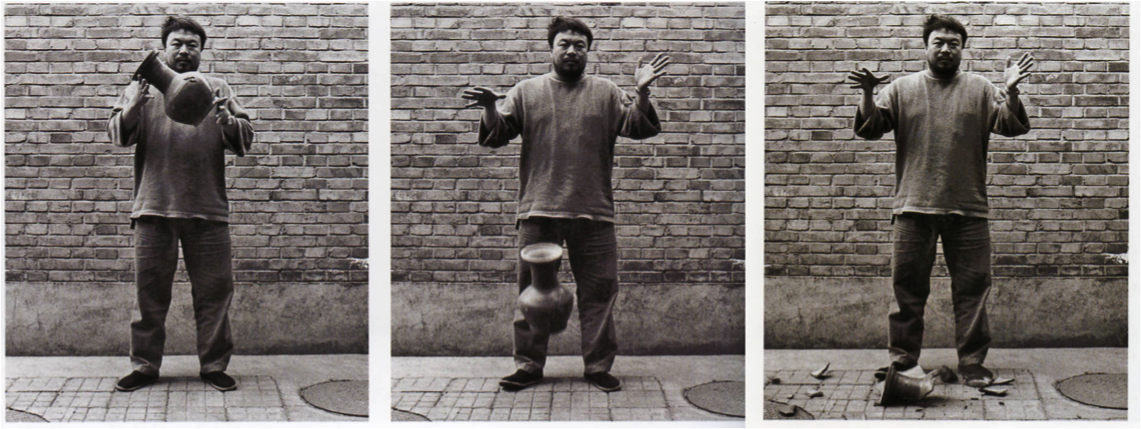
To express his attitude towards the order of preferences concerning art, and distinguish himself from the crowd of other artists, he changed the design of one of the Han dynasty urns by drawing on it a logo of Coca Cola company (fig.2).
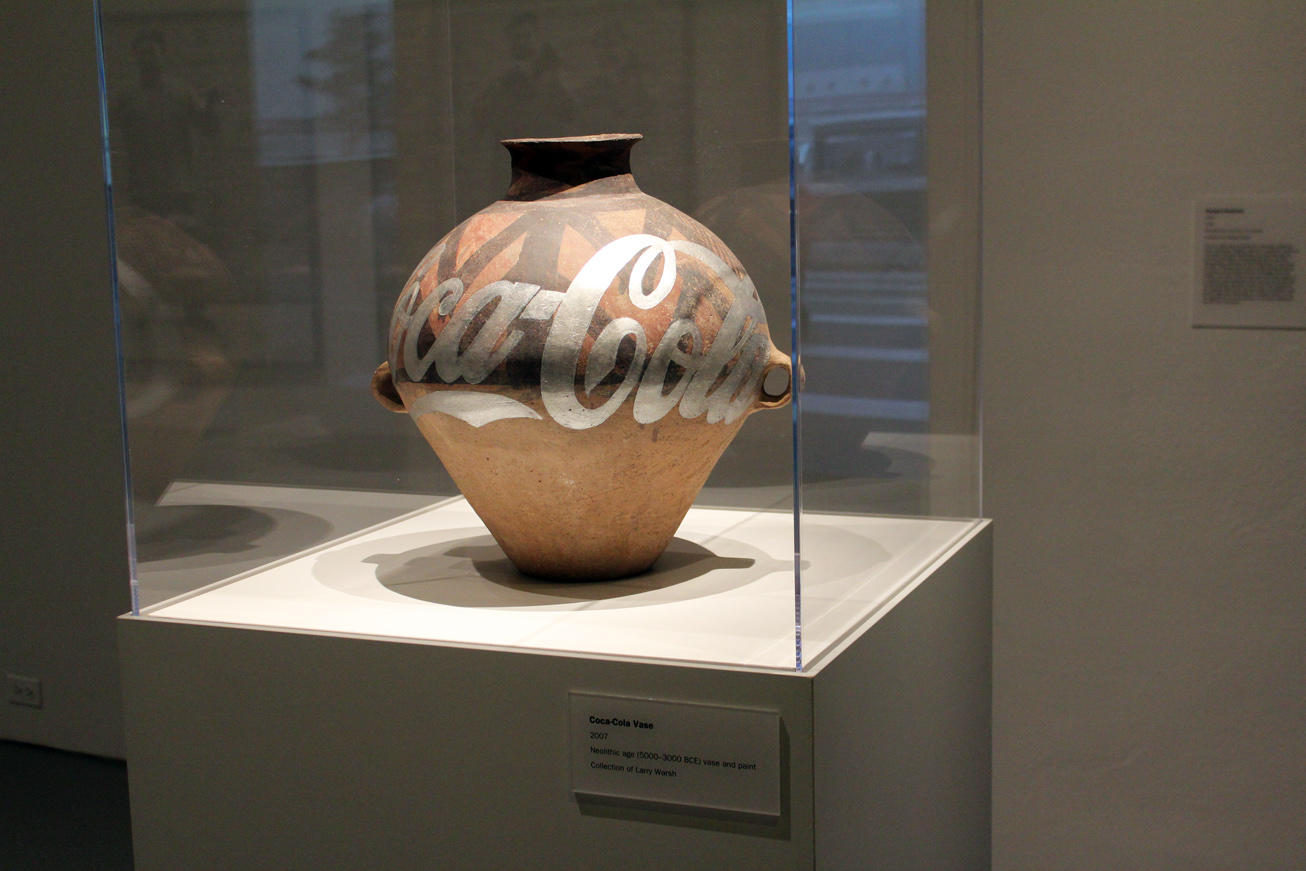
Nevertheless, he cannot be regarded as a person who does not have any respect to the traditions of his nation. The distinctive features of Chinese culture were used by him in order to create something new that would bridge the gap between traditional and revolutionary views on art.
To show how these two opposite approaches may coexist, he developed a project that presented a great construction consisting of archaicized vases. He is known as a person who tries to use everything material that can be turned into an art object. Thus, trying to look beyond the frame and create something that has no analogues in the world, he constructed an art object consisting of parts of a thousand bicycles (fig.3).
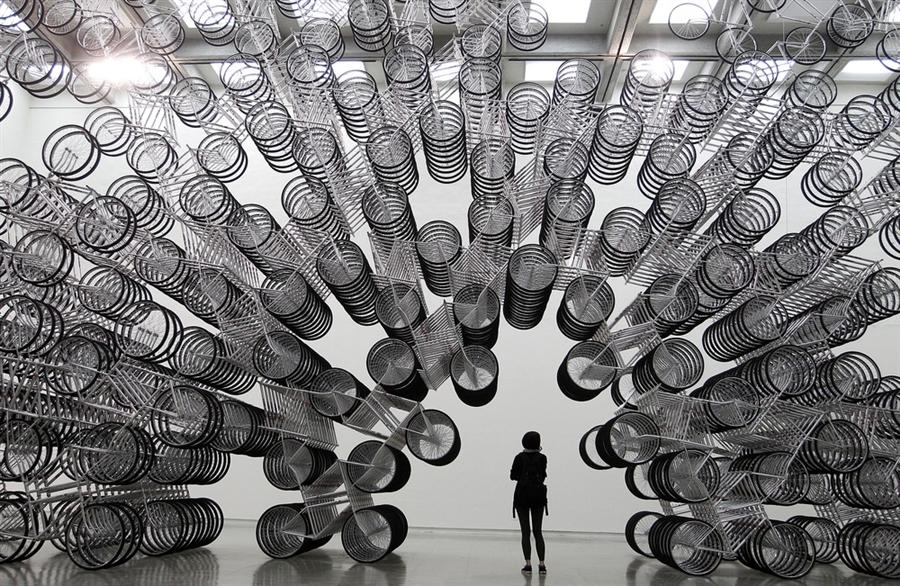
The artist’s choice of the material seems to reflect the facts of life in China, as many people living there prefer to ride a bicycle instead of using public transport. To some extent, this installation can be regarded as a monument to movement that helps people to stay alive and feel better. Worldmap is one of the most unusual art works created by Ai Weiwei. This piece of art consists of two thousand layers of white fabric, and the shape of different continents of the Earth is cut out from this fabric. This very work presents Ai Weiwei’s opinion on present status of his country in the world (fig.4).
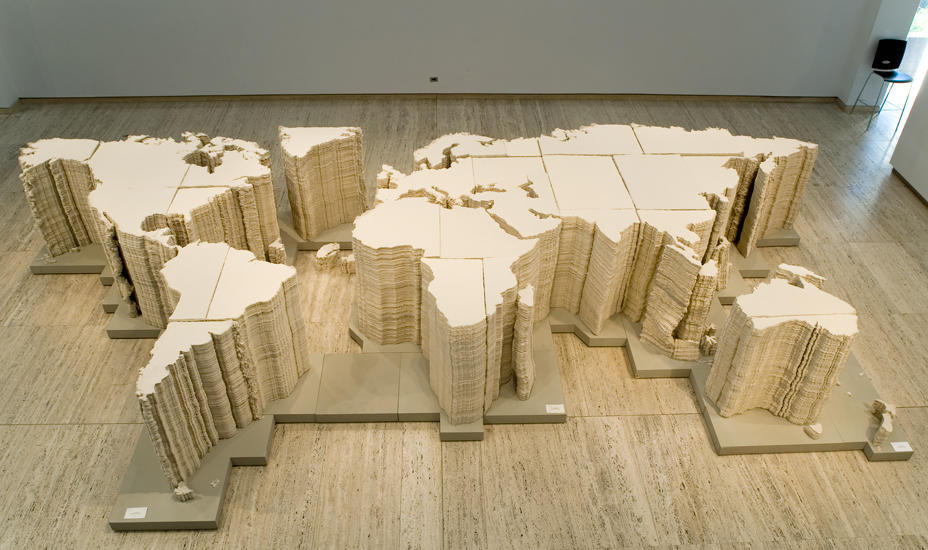
During the creation of this object of art, many Chinese volunteers were helping Ai Weiwei. By means of this project, the artist wanted to highlight the way that the world community sees China. The work symbolizes China’s being one of the countries with the cheapest labor force in the spheres of textile industry and fabrication.
Political and economic contexts seem to be reflected in Ai Weiwei’s art practices very often; more importantly, he managed to turn himself into a symbol of freedom of speech and a struggle against the regime. Although many people believe him to be a person who is just trying to attract an attention of a society, he definitely belongs to the number of people who contribute into the development of Chinese art.
Richard Prince: An Artist or a Thief?
Richard Prince is one of the most famous members of the contemporary art community of the United States. As a child, Prince lived in United States and in Great Britain. Having graduated from the university, he started working for a publishing company. In the end of 1970s he started his art career. Richard Prince is an artist who feels inspired by postmodern culture, and this fact influenced his decision to depart from the primary rule of any artist that prescribes to value the efforts made by other people.
Breaking the law of the honor many times, he has managed to build a successful career and become one of the richest artists of his generation. The phenomenon of Richard Prince and his financial success allows nobody to stay indifferent; there is a variety of opinions concerning his work and the question if he attaches any significance to the notions of honesty and conscience.
Many people could jump to the conclusion that his works are always regarded as obvious violation of intellectual property rights of other photographers and their models; in fact, the art by Richard Prince make the society divide into two large groups.
Although the majority of people do not see him as a talented person who tries hard to create something new in order to contribute to the contemporary art in United States, there is a group of people who consider him to be a real artist. According to the opinion expressed by many of his supporters. Richard Prince is just able to think out of the box and make enormous sums of money due to his inventiveness, and it would be a mistake to regard his work as the act of misappropriation.
Continuation Art by Richard Prince: What are the Messages of his Works?
As it is clear from the materials published by certain means of mass media, Richard Prince has managed to garner the support of some of his colleagues who see him not as a man misappropriating other people’s photographs and paintings but as a person who fights against insincerity and the pseudo-values of the society. In their opinion, these values become more and more popular in the United States and then spread all over the world. To all intents and purposes, his supporters claim that his mission is very important as he assails with criticism on modern culture that proclaims consumerism and obsession with a physical appearance.
First of all, Richard Prince is known as an artist who does not create the picture from the very beginning but works with pictures created by other people and adds a few tiny details in order to slightly change them. On the face of this situation, such actions seem to be an act of misappropriation of other people’s intellectual property; in fact, in accordance with the laws of the United States, incorporating any changes involves creating another object of art that becomes a property of this artist.
In his work, Richard Prince often touches upon the topics of social trends that are very popular among modern Americans. For example, one of his exhibitions in New York was devoted to the topic of popular social networks. To prepare for the exhibition, he “created” more than thirty printed images that had been posted by different people on their Instagram pages (fig.5).

The thing that is interesting about this situation is that people whose photos were stolen (among them were models and photographers) showed almost no response to the fact that their photos were sold at a very high price, and they were not given any money by Prince. As for him, this way of creating pictures and other objects of art has nothing to do with the real crime and dishonesty; he sees appropriation art as a good way to add something new to the works that already exist, and therefore, to whip other people’s photographs and paintings into shape.
What is more, there are people who believe this kind of art to be an essential reaction to the things that are happening in the Internet community. As they believe, with the rise of Internet, people have become more careless in reference to the information concerning their lives that they use on their pages in different social networks. This is why they should not be surprised when other people lay their hands on these pictures, and turn them into the objects of art that are of interest for many art collectors.
There is no doubt that the appropriateness of the methods that he uses and treasures of art of his works present quite a controversial topic. Nevertheless, Richard Prince may be called an artist who is successful at incarnating his own vision of mindset and the range of interests of typical American consumer in his works.
Thus, he has used a range of themes that are familiar to many Americans in order to create a few series of images. For instance, he has managed to exploit American art collectors’ passion to westerns and cowboys with help of creating a series of cowboy pictures (fig.6).
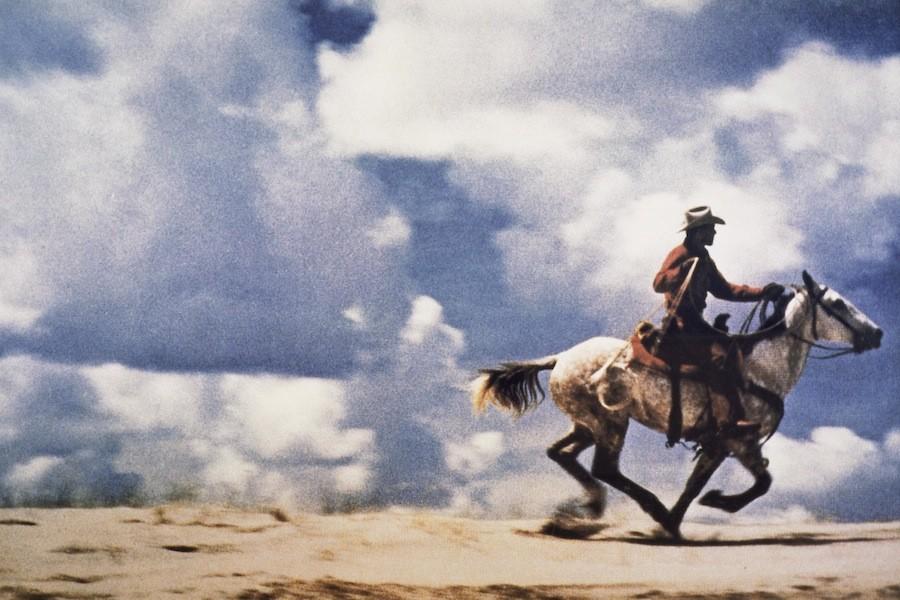
To create this photograph series, Richard Prince appropriated a few pictures from an advertisement of Marlboro cigarettes that was popular in the end of the 1970s. It is very important to pay attention to the reaction of the society to this innovative trick; it may sound surprising but the art community found the artist’s solution to be simple and amazing.
This art series was important because it attracted the attention of the society to the issues of singularity of art design and the authorship of art works. What is more, he was using the covers of cheap romance novels to create his pictures. Thus, a series of pictures called “Nurses” appeared (fig.7, fig.8).
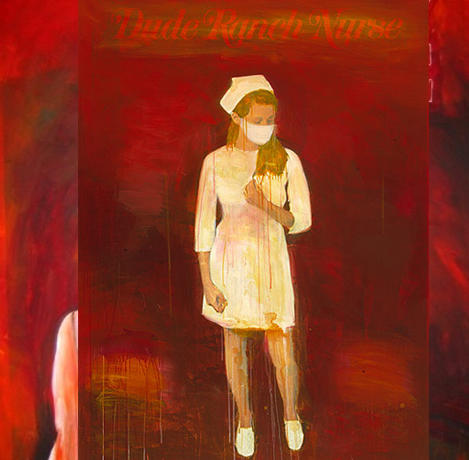
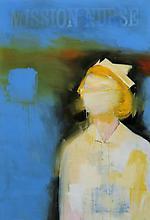
For instance, the images of the secondary characters were covered with paint, and the nurses’ facial expressions were changed so that the pictures looked terrifying. These pictures may be regarded as the artist’s vision of women’s image in the society. If we take a look at these pictures, it becomes obvious that the nurses are sexualized; what is more, they are deprived of their personal characters as their faces are covered with medical face masks.
According to Prince’s opinion, the same is true for the women living in modern society; it is essential as the ideas of consumer society are so popular that we start consuming people. Due to the meaning that he incorporates into these pictures, they can be regarded as a mirror reflecting the defects of modern society that keeps living in accordance with the pseudo-values.
Conclusion
In the end, it is clear that contemporary art practices allow artists to go beyond creating only beautiful objects; instead, they are able to express their opinion on many social causes and even fight against political regime. Due to that, contemporary art has turned into the tool reflecting the state of the society and encouraging it to change.
Bibliography
Ertug, Gokhan. “The Art of Representation: How Audience-Specific Reputations Affect Success in the Contemporary Art Field.” Academy of Management Journal 59, no.1 (2016): 113-134.
Horowitz, Noah. Art of the Deal: Contemporary Art in a Global Financial Market. Princeton: Princeton University Press, 2014.
McEvilley, Thomas. Capacity: The History, the World, and the Self in Contemporary Art and Criticism. New York: Routledge, 2016.
Osborne, Peter. Anywhere or Not at All: Philosophy of Contemporary Art. London: Verso, 2013.
Shanken, Edward. Contemporary Art and New Media. Oxford: John Wiley, 2016.
Smith, Terry. What is Contemporary Art? Chicago: University of Chicago Press, 2011.
Velthuis, Olav. Talking prices: Symbolic meanings of prices on the market for contemporary art. Princeton: Princeton University Press, 2013.